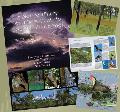Home Page Schools
Biodiversity is in real trouble world-wide and especially in Australia. As we draw closer to the end of the Biodiversity Decade of Action 2010 - 2020 the problems are actually getting worse. As people become more alienated from nature it makes it more likely that the natural systems in our world will be neglected and human impacts will make more changes to the biodiversity and the underlying processes in our world, processes which are not sustainable today and getting worse. UNESCO
Our Biodiversity Schools initiative, and its core element the Biodiversity Schools database are designed to help address the biodiversity crisis issue by focusing students’ attention on the natural elements of the world they live in and to build awareness of biodiversity. The initiative focuses on key strategies that lead to attitude change and a deep appreciation and understanding of the natural world.
Sir David Attenborough has called for a radical new approach to conservation, urging people to "use all spaces from gardens to roadside verges to help wildlife". School grounds are the perfect place to start. 'Nature deficit disorder' is a reality but technology is a part of the solution. For students technology is a significant and positive part of life, it is an amplifier that can help you focus and think. Contrast wandering around the school just looking compared to trying to get a photograph of a bird or a lizard. The level of focus is very different!
The Biodiversity Schools database is designed to help schools to harness the power of nature education and some technology strategies in their learning processes while implementing the Sustainability Cross-Curriculum priority. The Melbourne Declaration outlined a major strategy to address Sustainability through Education and this system provides an innovative way to achieve that. Wagaman Primary School in Darwin has been piloting the process with great success.













